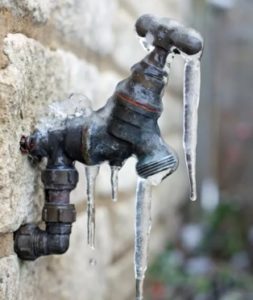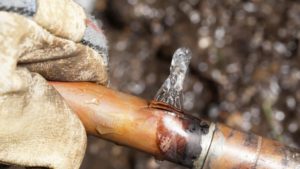 In order to avoid expensive and messy situations that frozen pipes cause, it is important to prepare well in advance. The following are a couple of methods on how you can prevent your Long Island home’s water pipes from freezing and the best way of thawing them in the event that they do freeze.
In order to avoid expensive and messy situations that frozen pipes cause, it is important to prepare well in advance. The following are a couple of methods on how you can prevent your Long Island home’s water pipes from freezing and the best way of thawing them in the event that they do freeze.
Why it is such a problem to have frozen water pipes?
Whenever water freezes, it ends up expanding inside of whatever it is contained in, and applies pressure to the surface from the inside. No matter how strong the vessel or pipes are that the frozen water are in, the pressure that is exerted by the expanding water will eventually break it.
Pipes that are directly exposed to low temperatures are the ones that freeze the most, like water supply lines to the home’s unheated interior parts, outdoor house pipes, and swimming pool supply lines.
Prevent freezing water pipes prior to the start of cold weather
You need to prepare for cold weather in order to prevent pipes from freezing. The instructions from your supplier may vary, but the first thing that needs to be done is to drain your sprinkler and swimming pool supply lines. Do not use antifreeze in those lines, since it is harmful to humans and pets. You also need to drain and store any lines that are used outdoors.
Close the inside valves supplying the outdoor pipes and make sure that the outside valves are kept open to allow any water in the pipe to expand without the pipe breaking. Check your entire plumbing system for water supply pipes that are in unheated areas such as the attic, basement, or crawl space. Insulate those pipes. If installing insulators isn’t something you want to do, then use can provide insulation to some extent by using newspapers.
Preventative action for cold weather
During cold weather there are a number of measures that can be taken to ensure your pipes don’t end up bursting due to freezing water. If your garage has any water supply lines, then your garage doors should be kept closed as much as you can. Keep your kitchen and bathroom cabinet doors open. That allows warmer air coming from the other parts of the home to circulate closer to your plumbing. Make sure chemicals and medications that are normally kept in those cabinets are out of reach of small children. In order to prevent pipes from freezing in very cold weather, water can be run slowly through them.
You also can save yourself lots of trouble by making sure your thermostat temperatures are kept constant no matter what time of day it is. Although that can result in higher power bills, that’s a small price to have to pay when compared with how much its cost to repair water pipes that have burst.
If you are planning on being away from your house during cold weather, your thermostat should be set at temperature over 55 degrees Fahrenheit.
How to thaw frozen pipes…
Whenever you turn a faucet on and drips are all that come out, usually the problem is a frozen pipe. Those pipes that have a tendency to freeze the most are those that are against an exterior wall and where the main service water pipes go into the house. When you are treating frozen pipes, the faucet should be kept open to allow water to flow out as it starts to melt. Water can also be run through frozen pipes so that the ice melts easier.
An electric heater pad can be used to wrap around the pipe so that heat is applied to the frozen part of the pipe. The pipes can also be wrapped with towels that have been soaked in hot water to offer some extra heater. A portable space heater and electric hairdryers are also ideal tools to heat frozen pipes. They however do need to be kept away from any flammable materials.
Using open flame devices should also be avoided such as charcoal stoves, blowtorch, propane heater and kerosene heater. Heat should be applied to a frozen pipe until there is a fully restoration of water pressure and the water is once again flowing freely and normally. If you are not able to find a frozen area or there is one that is inaccessible, then you should contact a professional plumber and don’t try to reach or find it. You could make things even worse and more damage could be done to your plumbing than good.
When a pipe freezes, usually there are others that might also be frozen. You need to check all of the other faucets in your home to determine how extensive your problem is. Whenever you have a doubt, get help from a licensed plumber.
Future planning
To provide your pipes with more insulation and protection, you can move them to areas that are less expose to severe weather conditions and are more covered. In addition you should look for ways of maintaining higher temperatures in areas such as the basement and attic to add more insulation. That will help to ensure the pipes in those areas don’t burst or freeze.
Hopefully this information has helped you should you have frozen water pipes. If you need professional help please feel free to call us for emergency plumbing services to repair frozen pipes.
 Mother Nature can wreak havoc on your plumbing system very quickly. When temperatures plummet on Long Island your pipes can become frozen and burst, resulting in serious damage to your home. If your pipes become frozen, you must act quickly to thaw them and prevent your pipes from bursting due to rising pressure within your pipes.
Mother Nature can wreak havoc on your plumbing system very quickly. When temperatures plummet on Long Island your pipes can become frozen and burst, resulting in serious damage to your home. If your pipes become frozen, you must act quickly to thaw them and prevent your pipes from bursting due to rising pressure within your pipes.
 In order to avoid expensive and messy situations that frozen pipes cause, it is important to prepare well in advance. The following are a couple of methods on how you can prevent your Long Island home’s water pipes from freezing and the best way of thawing them in the event that they do freeze.
In order to avoid expensive and messy situations that frozen pipes cause, it is important to prepare well in advance. The following are a couple of methods on how you can prevent your Long Island home’s water pipes from freezing and the best way of thawing them in the event that they do freeze.